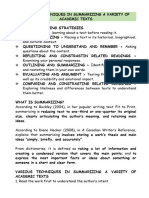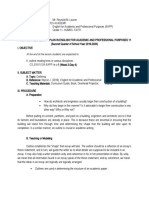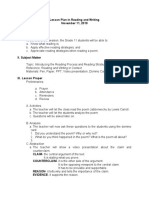0 ratings0% found this document useful (0 votes)
133 viewsAcademic Text Quiz
Academic Text Quiz
Uploaded by
aizaThe document provides a series of true/false and multiple choice questions about academic writing. It tests understanding of key elements of academic papers like their structure, appropriate tone and language, purpose, and targeting the intended audience. Correct answers are provided to help assess knowledge of formal writing conventions and best practices for research papers.
Copyright:
© All Rights Reserved
Available Formats
Download as DOCX, PDF, TXT or read online from Scribd
Academic Text Quiz
Academic Text Quiz
Uploaded by
aiza0 ratings0% found this document useful (0 votes)
133 views4 pagesThe document provides a series of true/false and multiple choice questions about academic writing. It tests understanding of key elements of academic papers like their structure, appropriate tone and language, purpose, and targeting the intended audience. Correct answers are provided to help assess knowledge of formal writing conventions and best practices for research papers.
Original Title
academic text quiz
Copyright
© © All Rights Reserved
Available Formats
DOCX, PDF, TXT or read online from Scribd
Share this document
Did you find this document useful?
Is this content inappropriate?
The document provides a series of true/false and multiple choice questions about academic writing. It tests understanding of key elements of academic papers like their structure, appropriate tone and language, purpose, and targeting the intended audience. Correct answers are provided to help assess knowledge of formal writing conventions and best practices for research papers.
Copyright:
© All Rights Reserved
Available Formats
Download as DOCX, PDF, TXT or read online from Scribd
Download as docx, pdf, or txt
0 ratings0% found this document useful (0 votes)
133 views4 pagesAcademic Text Quiz
Academic Text Quiz
Uploaded by
aizaThe document provides a series of true/false and multiple choice questions about academic writing. It tests understanding of key elements of academic papers like their structure, appropriate tone and language, purpose, and targeting the intended audience. Correct answers are provided to help assess knowledge of formal writing conventions and best practices for research papers.
Copyright:
© All Rights Reserved
Available Formats
Download as DOCX, PDF, TXT or read online from Scribd
Download as docx, pdf, or txt
You are on page 1of 4
Let’s answer this!
TRUE OR FALSE
Directions: Write T if the statement is correct and F if it is wrong.
Write your answer in your notebook.
1. Formality in academic writing requires precision to make a
legitimate piece of writing. T
2. Writing is a form of communication that is shaped by the
following factors: topic, role, and audience. T
3. The use of personal pronouns such as I, you, and we is
acceptable in academic writing. F
4. “How can these problems be solved?” is an example of a critical question. T
5. Because is an example of transitional device that expresses cause and effect. T
6. An abstract is a summary of a novel. F
7. The conclusion is the section that summarizes the main points of the essay. T
8. A summary is a condensed form of a text which is usually
half of the original material. F
9. To introduce a topic in an essay, the writer must be able to explain its details. F
10. A research paper contains background of the study, body and
recommendations. F
Directions: Below are jumbled parts of a common research paper.
Put them into the correct order by using numbers to represent the
sequence. Write your answer in your notebook.
A. 4 Presentation of the Research Problem
B. 1 Title of the Research Paper
C. 7 Presentation of the Results
D. 9 Recommendations
E. 3 Overview or Scope of Research
F. 8 Interpretation and Discussion of Results
G. 10 The Reference List
H. 2 The Abstract
I. 5 Review of Past Research Relevant to the Paper
Description of Methods used to Carry out the
J. 6 Research
Multiple Choice
Directions: Choose the letter that best answers the given question.
Write the letter of your answer in your notebook.
1. Who are the target readers of an academic essay?
A. Parents, workers, teachers
B. Teachers, students, academic community
C. Students, out-of-school youth, government officials
D. None of the above
2. What are the purposes of doing an academic writing?
A. To settle, to negotiate and to inform
B. To defend, to challenge and to question
C. To inform, to persuade and to argue a specific point
D. To guess, to hypothesize and to make conclusions
3. Writing academic papers requires deliberate, thorough and careful
thought. Therefore, what should one do to achieve a well-crafted
academic essay?
A. One must depend on his/her own opinions alone.
B. One must conduct a research on the topic at hand.
C. One must not consult the Internet for unsure sources.
D. One must depend highly on the Internet for
easy information access.
4. An academic essay must use appropriate vocabulary words but
not too pretentious, highfalutin words. Which among these words is
the simplified version of the term, "supercalifragilisticexpialidocious"?
A. beautiful; pretty
B. exquisite; one-of-a-kind
C. extraordinarily good; wonderful
D. hardworking; industrious
5. What are the three main parts of an essay?
A. The hook, the main idea and the conclusion.
B. The introduction, the body and the conclusion.
C. The topic sentence, the body and the conclusion.
D. None of the above
6. What is the purpose of topic sentence?
A. To give coherence to the paragraph.
B. To help with the flow of sentences.
C. To help the reader understand what the paragraph will be about.
D. None of the above.
7. What is 'academic writing'?
A. A technique to write balanced, accurate
and professional assignments
B. An old-fashioned way of writing.
C. How university professors write.
D. The writing you find in textbooks
8. Choose three words to describe academic writing:
A. Talented, stylish, inspiring
B. Precise, clear, objective
C. Decisive, divisive, derisive
D. Subjective, obscure, vague
9. What is true of the introductory paragraph?
A. ends with the thesis.
B. introduces the big idea of the essay
C. starts with a hook
D. all of these
10. What is the sequence of an essay?
A. Introduction, Body Paragraph, Body Paragraph, Conclusion
B. Body Paragraph, Introduction, Conclusion, Body Paragraph
C. Introduction, Body Paragraph, Conclusion, Body Paragraph
D. Conclusion, Introduction, Body Paragraph, Body Paragraph
You might also like
- Motion For Execution (Small Claims)Document2 pagesMotion For Execution (Small Claims)Anton David0% (1)
- English7 - q1 - Mod7 - Using Appropriate Reading Styles For One's Purpose - v5Document25 pagesEnglish7 - q1 - Mod7 - Using Appropriate Reading Styles For One's Purpose - v5Aizelle SalibayNo ratings yet
- Outlining A TextDocument6 pagesOutlining A TextJulieSanchezErsandoNo ratings yet
- EAPP Lesson 1Document17 pagesEAPP Lesson 1نجشو گحوشNo ratings yet
- Eapp Module1 Q2W1Document14 pagesEapp Module1 Q2W1Lireea GhustaNo ratings yet
- Academic and Non-Academic TextsDocument23 pagesAcademic and Non-Academic TextsBeatriz Helaena RasonableNo ratings yet
- Subject Verb Agreement Grade 7 2018-2019Document45 pagesSubject Verb Agreement Grade 7 2018-2019HanzoNo ratings yet
- Abstract, Precis, SummaryDocument13 pagesAbstract, Precis, SummaryDale Jose GarchitorenaNo ratings yet
- Eapp Module 1Document8 pagesEapp Module 1Fram FernandezNo ratings yet
- Learning Activity Sheet in 21 Century Literature From The Philippines and The WorldDocument9 pagesLearning Activity Sheet in 21 Century Literature From The Philippines and The WorldLILIAN ROSE DE LARANo ratings yet
- English For Academic and Professional Purposes - MELC AlignedDocument65 pagesEnglish For Academic and Professional Purposes - MELC AlignedMarlon Gonzales100% (1)
- Test Questions On Position Papers Blooms Taxonomy Edition 10 ItemsDocument3 pagesTest Questions On Position Papers Blooms Taxonomy Edition 10 Itemsezabellesomolostro013No ratings yet
- EAPP 11 Summative 1Document6 pagesEAPP 11 Summative 1Hillary RufinoNo ratings yet
- Compilation in Philippine Literature 2Document12 pagesCompilation in Philippine Literature 2VinNo ratings yet
- Lesson 5 Critical Reading SkillsDocument49 pagesLesson 5 Critical Reading SkillsDennis EmNo ratings yet
- English10 Q1 Mod3 Pronouns V3Document26 pagesEnglish10 Q1 Mod3 Pronouns V3vinetablategmail.com TablateNo ratings yet
- Declamation Speech RubricDocument3 pagesDeclamation Speech Rubricmark dominicNo ratings yet
- Genres of Viewing: The College of Maasin "Nisi Dominus Frustra"Document17 pagesGenres of Viewing: The College of Maasin "Nisi Dominus Frustra"TrixiaNo ratings yet
- Rubric For Assessment of The Personal EssayDocument2 pagesRubric For Assessment of The Personal EssayEdwin EstradaNo ratings yet
- Lesson 1 Text As A Connected Discourse: EN11/12OC-IA-4Document41 pagesLesson 1 Text As A Connected Discourse: EN11/12OC-IA-4Medy Lumagui MarasiganNo ratings yet
- EAPP Notes Various TechniquesDocument5 pagesEAPP Notes Various TechniquesAbigail Ambrosio (ABI)No ratings yet
- DLP English 7Document7 pagesDLP English 7Rey NonNo ratings yet
- WEEK 5 EAAP Position PapersDocument10 pagesWEEK 5 EAAP Position PapersKreshia Kyrelle Bundal100% (1)
- Lesson Plan in EAPPDocument4 pagesLesson Plan in EAPPKimberly PinuelaNo ratings yet
- Test On Vocabulary Dev't.Document1 pageTest On Vocabulary Dev't.Lovilla DalogNo ratings yet
- WLP English 8 Q1 W8Document3 pagesWLP English 8 Q1 W8Ryan Anoche BertuldesNo ratings yet
- 2nd Diagnostic Test in EAPPDocument3 pages2nd Diagnostic Test in EAPPGilbert NarteNo ratings yet
- WLP Eapp Week3Document7 pagesWLP Eapp Week3Imara AbdalaNo ratings yet
- EAPP Quarter 1 Module 5Document6 pagesEAPP Quarter 1 Module 5John LobosNo ratings yet
- Q3 - LE - English 7 - Lesson 1 - Week 2Document16 pagesQ3 - LE - English 7 - Lesson 1 - Week 2Melanie Rafaela-LoronoNo ratings yet
- Lesson Plan Cot 2 EappDocument7 pagesLesson Plan Cot 2 EappLalaine Vequizo100% (1)
- Writing An Abstract Precis or Summary - PPTX 20231107 061832 0000Document18 pagesWriting An Abstract Precis or Summary - PPTX 20231107 061832 0000zeusskylermartiresNo ratings yet
- EAPP LP - Position PaperDocument3 pagesEAPP LP - Position Paperkristine angela baldestamonNo ratings yet
- ESTRELLA - Detailed Lesson Plan in ResearchDocument7 pagesESTRELLA - Detailed Lesson Plan in ResearchNorlie ArevaloNo ratings yet
- EngleAPP Planning Essays and PresentationsDocument22 pagesEngleAPP Planning Essays and PresentationsAira Yu - Aliwalas100% (2)
- Performance Task in EAPPDocument6 pagesPerformance Task in EAPPAlexandra BalmoriNo ratings yet
- English For Academic and Professional Purposes (EAPP) Q1/Q3-Module 1 Language Used in Academic TextDocument11 pagesEnglish For Academic and Professional Purposes (EAPP) Q1/Q3-Module 1 Language Used in Academic Textjared alonzoNo ratings yet
- Ranking - EappDocument7 pagesRanking - EappREYNNo ratings yet
- Pliant Like The Bamboo LPDocument6 pagesPliant Like The Bamboo LPRachel AgustinNo ratings yet
- Streamlining Grade 9 First QuarterDocument3 pagesStreamlining Grade 9 First QuarterAbigail Gumabay100% (1)
- THE GERMAN EPIC Lesson PlanDocument2 pagesTHE GERMAN EPIC Lesson PlanAsvag OndaNo ratings yet
- English: Quarter 2 - Module 4: Extracting Information Using A Summary, A Precis andDocument51 pagesEnglish: Quarter 2 - Module 4: Extracting Information Using A Summary, A Precis andLigaya Tungcul-SimanganNo ratings yet
- Grade 9 Quiz BeeDocument2 pagesGrade 9 Quiz BeeMaxpein AbiNo ratings yet
- I. ObjectivesDocument4 pagesI. ObjectivesJason Pastera100% (1)
- English 10 Q3 Module 5Document26 pagesEnglish 10 Q3 Module 5Carissa Lagman JavinalNo ratings yet
- Test Eapp Manifesto and StandDocument2 pagesTest Eapp Manifesto and StandKristine Angelica GabrielNo ratings yet
- Activity On Precis WritingDocument2 pagesActivity On Precis WritingChernie Deroma ObsenaresNo ratings yet
- DLP.A Grade 10Document9 pagesDLP.A Grade 10cecilynNo ratings yet
- Segmental and Suprasegmental FeaturesDocument1 pageSegmental and Suprasegmental FeaturesSwarupa KannaNo ratings yet
- Eapp Lesson 6 Facts and OpinionDocument23 pagesEapp Lesson 6 Facts and OpinionAnonymous B6Zc9h02d5No ratings yet
- LAS English in Academic Purpose Quarter 4 Module 4Document4 pagesLAS English in Academic Purpose Quarter 4 Module 4Abigail MasotisNo ratings yet
- It Is A Truth Universally Acknowledged That A Single Man in Possession of A Good Fortune, Must Be in Want of A WifeDocument8 pagesIt Is A Truth Universally Acknowledged That A Single Man in Possession of A Good Fortune, Must Be in Want of A WifeJaycelyn BaduaNo ratings yet
- Elements of A Short Story With Cinderella ExamplesDocument13 pagesElements of A Short Story With Cinderella ExamplesAthelo Gio HernandezNo ratings yet
- EAPP Summative Test - Midterm ExaminationDocument4 pagesEAPP Summative Test - Midterm Examinationanalisa monteroNo ratings yet
- LP For Reading Process and Reading StrategiesDocument2 pagesLP For Reading Process and Reading StrategiesMervin BauyaNo ratings yet
- Week-4 - Eapp DLPDocument3 pagesWeek-4 - Eapp DLPAira Mae LegaspiNo ratings yet
- Eapp Q4 Week1Document28 pagesEapp Q4 Week1Christine Sta AnaNo ratings yet
- Semi-Detailed Lesson PlanDocument2 pagesSemi-Detailed Lesson PlanJoselle Cayanan LawNo ratings yet
- EAPP 1st Examination ReviewerDocument4 pagesEAPP 1st Examination ReviewerAlex ComonNo ratings yet
- Module5 EappDocument11 pagesModule5 EappRonalis PowellNo ratings yet
- Lingkod - Pursuing Discipline-Based and Interest-Based ApproachesDocument31 pagesLingkod - Pursuing Discipline-Based and Interest-Based ApproachesJames Geronimo LopezNo ratings yet
- Aryan Verma ResumeDocument2 pagesAryan Verma ResumeAdityaSinghNo ratings yet
- Binomial and Poisson DistributionDocument26 pagesBinomial and Poisson Distributionmahnoorjamali853No ratings yet
- Peer Review Evelyn Tovar Essay 2 ContentDocument3 pagesPeer Review Evelyn Tovar Essay 2 Contentapi-708207862No ratings yet
- Brutalist ArchitectureDocument21 pagesBrutalist Architectureshaimasaraireh5No ratings yet
- Desaster Research at The CrossroadsDocument26 pagesDesaster Research at The CrossroadsGiselly SantiagoNo ratings yet
- GHCDC MAD SCI Engeneers ReportDocument117 pagesGHCDC MAD SCI Engeneers ReportGGHMADNo ratings yet
- LO-006A - Certificate of Course CompletionDocument15 pagesLO-006A - Certificate of Course Completionkumar kartikeyaNo ratings yet
- Nietzsche and NihilismDocument5 pagesNietzsche and NihilismDiego AlmarzaNo ratings yet
- Omnicolor BrochureDocument16 pagesOmnicolor Brochuresoner ozdenNo ratings yet
- Nov. 2, 2011 IssueDocument16 pagesNov. 2, 2011 IssuePulaskiNewsNo ratings yet
- Kepner-Tregoe: A Systematic Problem Solving & Decision Making MethodDocument26 pagesKepner-Tregoe: A Systematic Problem Solving & Decision Making MethodGaurav M. Advani100% (2)
- Halsey Premium Plan: SolutionDocument4 pagesHalsey Premium Plan: SolutionSilpashree MandalNo ratings yet
- Solvent Sbps 1425 - HPCLDocument2 pagesSolvent Sbps 1425 - HPCLBharat ChatrathNo ratings yet
- Focus4 2E Grammar Quiz Unit5 5 GroupA 1kolDocument2 pagesFocus4 2E Grammar Quiz Unit5 5 GroupA 1kolAleksandra GonetNo ratings yet
- Inverter UnitDocument28 pagesInverter UnitE-dot ProjectNo ratings yet
- Review Encyclopedia of TaoismDocument2 pagesReview Encyclopedia of Taoism马德武No ratings yet
- Parabola Selfie RubricsDocument1 pageParabola Selfie RubricsMaegan Morales100% (1)
- 18.1-FAMILY ENTEROBACTERIACEAE and TESTSDocument2 pages18.1-FAMILY ENTEROBACTERIACEAE and TESTSJesette KhoNo ratings yet
- Compilation of Performance: (With Rubric) Quarter: Third Subject: English 10Document4 pagesCompilation of Performance: (With Rubric) Quarter: Third Subject: English 10CarlaTorreNo ratings yet
- Personal Development: Quarter 2 - Module 2: Social Relationships in Middle and Late AdolescenceDocument18 pagesPersonal Development: Quarter 2 - Module 2: Social Relationships in Middle and Late AdolescenceKaleed DrixNo ratings yet
- ASCE 52 - Guide For Design of Steel Transmission TowersDocument73 pagesASCE 52 - Guide For Design of Steel Transmission TowersFelipe DornellesNo ratings yet
- The Disputed Mosque A Historical InquiryDocument156 pagesThe Disputed Mosque A Historical InquiryEmma100% (1)
- Bonsai Guide For The BeginnerDocument21 pagesBonsai Guide For The BeginnerVidhyaa Saagar0% (1)
- Class 12 Accounts Pre-Board CorrectDocument7 pagesClass 12 Accounts Pre-Board CorrectHarini NarayananNo ratings yet
- Thewordsearch-Com-Cultural-Activities-5747223 2Document1 pageThewordsearch-Com-Cultural-Activities-5747223 2ByeNo ratings yet
- An Analysis of Expression of Anger in Movie " Harry Potter and The Piloshoper Stone "Document8 pagesAn Analysis of Expression of Anger in Movie " Harry Potter and The Piloshoper Stone "lailani indah budiNo ratings yet
- Gary Douglas Jester v. United States, 714 F.2d 97, 11th Cir. (1983)Document4 pagesGary Douglas Jester v. United States, 714 F.2d 97, 11th Cir. (1983)Scribd Government DocsNo ratings yet
- I410 Ecn 0199 2022 001 000168432Document13 pagesI410 Ecn 0199 2022 001 000168432kwym31No ratings yet

























































































